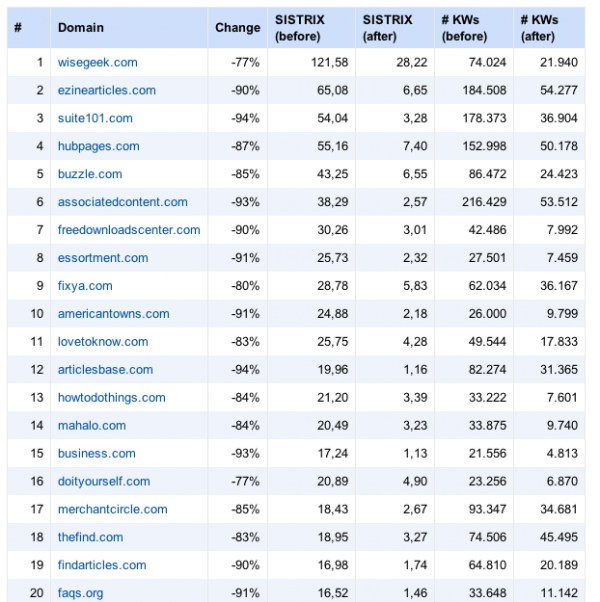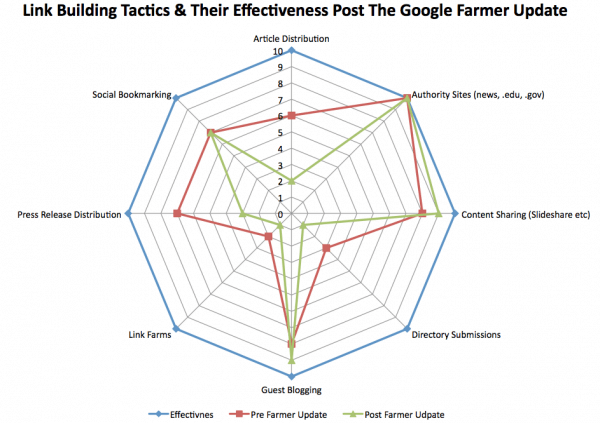Over a month after the Google Farmer update rolled out in the US, the SEO world seems to have settled back down again. As with all Google updates the winners are left breathing a sigh of relief while the losers are frantically trying to correct their strategy and regain their previous rankings & traffic levels. I hope the ideas here help if you're in the latter category.
If you have yet to read about the Google Farmer update the following articles are good background:
But for us, this is the best summary of the impact - it's a compilation by SISTRIX showing how article sites were affected by the Google Farmer update:

The most dramatic is the number of keywords that these sites rank for. Seems SISTRIX have a useful index and technology for benchmarking the SEO effectiveness of sites and how they perform through time! We'd be interested to know about companies who use this for tracking.
Importance of Link Building Tactics, before & after...
Since the launch of the Google Farmer-Panda update, some core traditional SEO tactics have reduced in their effectiveness. The graphic below outlines my thoughts on the difference for specific tactics before and after the Google Farmer update. If I had to summarise the Google Farmer update in one paragraph here is what I would say:
If you utilized websites / services that either hosted or distributed your content onto low quality content hubs that often contained more adverts than content, you are likely to have suffered as a result of this update. Any such services were always havens for poor quality content & lazy marketers. It was a low energy way to generate links. Of all the Google updates I think this one will have a more positive impact on the industry and really help it become a more exciting & non technical / geeky channel. It supports marketers who want to build engaging online brands!

3 Tips for link building in 2011
1. Don't focus on the link
It's all to easy to just go after a link, so much so that you only ever measure yourself on how many links you have or how many more than your competitors your website has. While this is one KPI, if links doesn't drive traffic or conversions either directly or through ranking increases, then it is not worth the time & effort.
Instead focus your time & energy on creating reasons for people to want to link to you. This could be because you are generating amazing blog posts, publishing white papers that raise the bar in your industry or it could be that you turn complex ebooks into interesting graphics that are easy to consume.
So, think about your audience and create content that they will find amazing & deliver it in a way that makes it fun to consume. If you get this right, then people will link to you or they will request to feature you on their site. This approach can help generate shares and tweet to your network (all good for your social score), or a blog post reviewing your content but this will ensure a much. more natural & scalable way to generate links.
2. Make your content inherently sharable
As mentioned above, core to successful & natural link building is amazing content. Making that content easy to share, reference & interact with is just as important. Giving visitors the option to share the content direct from the page through tools like Facebook likes, Twitter, Digg, Delicious, StumbleUpon as well as the more traditional bookmarking & send to a friend services will give you the best chance of your content been linked to and shared. Second to this, is making content easy to access through publishing content on sites like SlideShare, Flickr, YouTube, LinkedIn, Feedburner etc. By publishing your content on and via such platforms you make your content accessible to people and therefore they are more likely to a) find your content b) share / link / comment on your content both of which are key to generating links.
3. Create a relationships not links
In the past link building has been about building a list of websites you think you need a link from and then trying to work out the best way to "get" on that website. Times however have moved on and that method was never very effective anyway.
Instead, consider where your audience are currently active online and think if there is a way you can add value to their experience on those websites. This could be by becoming an active member of the community or it could be by forming a relationship with the site owner where you feature as a guest blogger or maybe you supply ebooks / white papers for them to use on their websites. Back to my initial tip, do not approach it for the link, approach it from adding value to the customers this way you will create a relationship both with other websites but crucially its users. This will help grow awareness of you / your brand which in-turn will generate traffic to your website and therefore give your content more opportunities to be shared.








